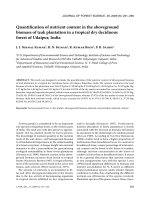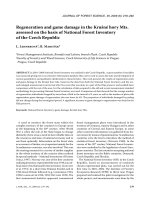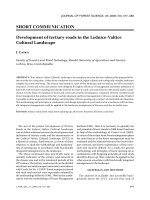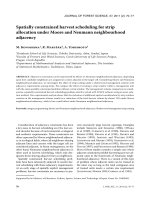Báo cáo lâm nghiệp: "Oak decline risk rating for the southeastern United States" ppt
Bạn đang xem bản rút gọn của tài liệu. Xem và tải ngay bản đầy đủ của tài liệu tại đây (532.36 KB, 10 trang )
Original
article
Oak
decline
risk
rating
for
the
southeastern
United
States
S Oak
F
Tainter
J
Williams
D
Starkey
1
USDA
Forest
Service,
Southern
Region
Forest
Health,
1720
Peachtree
Road
NW,
Atlanta,
GA
30367;
2
Department
of
Forestry,
Clemson
University,
Clemson,
SC
29634-1103,
USA
(Received
1
November
1994;
accepted
22
June
1995)
Summary —
Oak
decline
risk
rating
models
were
developed
for
upland
hardwood
forests
in
the
south-
eastern
United
States
using
data
gathered
during
regional
oak
decline
surveys.
Stepwise
discrimi-
nant
analyses
were
used
to
relate
12
stand
and
site
variables
with
major
oak
decline
incidence
for
each
of
three
subregions
plus
one
incorporating
all
subregions.
The
best
model
for
the
northern
Appalachian
subregion
included
soil
depth
class,
oak
basal
area,
site
index,
and
stand
age
(R
2
=
0.65).
In
the
southern
Appalachian
subregion,
significant
variables
included
slope
gradient,
soil
depth
class,
oak
basal
area,
and
clay
content
(R
2
=
0.30).
The
Ozark model
included
clay
content,
slope
gradient,
and oak
basal
area
(R
2
=
0.32).
The
composite
model
included
site
index/age,
clay
content,
slope
gradient,
soil
depth
class,
and
oak
basal
area
(R
2
=
0.22).
The
relatively
low
R2
values
and
variation
in
the
relationships
for
some
attributes
suggest
that
major
oak
decline
events
may
be
influenced
by
additional
factors.
oak
decline
/
risk
rating
/
predictive
model
Résumé—
Évaluation
du
risque
de
dépérissement
des
chênes
pour
le
sud-est
des
États-Unis.
Des
modèles
d’évaluation
du
risque
de
dépérissement
de
chênes
ont
été
établis
pour
des
forêts
feuillues
d’altitude
du
sud-est
des
États-Unis
en
utilisant
des
données
recueillies
au
cours
des
enquêtes
régionales
sur
le
dépérissement
des
chênes.
Au
total,
15
variables
relatives
au
site
et
aux
placettes
ont
été
corrélées
à
l’intensité
du
dépérissement
en
utilisant
des
analyses
discriminantes
par
étapes.
Des
modèles
prédictifs
ont
été
développés
pour
chacune
des
trois
sous-régions,
ainsi
que
pour
une
zone
plus
vaste
comprenant
les
trois
sous-régions.
Le
meilleur
modèle
pour
la
sous-région
«Nord-Appalache»
comportait
les
facteurs
suivants :
profondeur
(par
classe)
du
sol,
surface
basale,
index
de
site
et
âge
du
placeau
(R
2
=
0,65).
Dans
la
sous-région
«Sud-Appalache»,
les
variables
les
plus
significatives
étaient
la
pente,
la
profondeur
du
sol,
la
surface
basale,
et
la
quantité
d’argile
(R
2
=
0.30).
Le
modèle
«Ozark»
comprenait
les
variables :
quantité
d’argile,
pente,
et
surface
basale
(R
2
=
0.32).
Le
modèle
global
com-
prenait
les
facteurs :
index
du
site/âge
du
placeau,
quantité
d’argile,
pente,
profondeur
du
sol
et
sur-
face
basale
(R
2
=
0.22).
Les
valeurs
R2
relativement
faibles
et
la
variation
des
relations
entre
ces
paramètres
suggèrent
la
possibilité
que
les
incidents
majeurs
de
dépérissement
de
chênes
soit
fortement
influencés
par
des
facteurs
additionnels.
dépérissement
de
chênes / évaluation
de
risque / modèles
prédictifs
INTRODUCTION
Oak
decline
in
the
southeastern
United
States
is
a
widespread
disease
complex
with
a
long
history.
Reported
occurrences
date
to
the
mid-1850s
(Hopkins,
1902)
and
the
early
part
of
this
century
(Beal,
1926;
Balch,
1927).
A
perceived
increase
in
visible
damage
during
the
early
1980s
stimulated
efforts
to
determine
whether
these
increases
were
in
fact
occurring.
Periodic
multi-
resource
inventories
based
on a
network
of
permanent
plots
covering
the
region
already
existed
and
have
confirmed
these
percep-
tions.
Large
increases
in
hardwood
mortal-
ity
(Bechtold
et
al,
1987;
Brown,
1993)
were
detected.
Oak
decline
symptoms
occurred
on
approximately
1.6
million
ha
in
12
states
(Starkey
et
al,
in
preparation).
This
area
rep-
resented
nearly
10%
of
the
host
type.
Other
work
was
initiated
to
determine
stand
and
site
attributes
of
affected
and
healthy
areas.
Surveys
were
concentrated
in,
but
not
limited
to,
national
forests
in
the
Appalachian
and
Ozark
Mountains
in
the
southeastern
United
States.
These
combi-
nations
of
landforms
and
ownership
class
are
dominated
by
mixed
hardwood
forests
with
a
large
oak
component
and
were
per-
ceived
to
have
the
highest
incidence
of
decline
in
the
region.
Surveys
included
an
evaluation
of
38
severely
affected
areas
in
ten
states
(Survey
1;
Starkey
et
al,
1989);
an
aerial
photo-ground
survey
of
three
widely
dispersed
national
forest
districts
(Survey
2;
Oak
et
al,
1990);
and
a
detailed
analysis
of
the
multi-resource
inventory
of
western
Virginia
(Survey
3;
Oak
et
al,
1991),
the
state
with
the
highest
incidence
and
largest
affected
area
in
the
region
(Starkey
et
al,
in
preparation).
Consistent
associations
between
certain
stand-site
factors
and
oak
decline
and
mortality
were
detected
in
the
different
surveys.
Relatively
high
incidence
of
oak
mortality
and advanced
decline
symp-
toms
(ie,
progressive
crown
dieback
of
dom-
inant
and
codominant
oaks)
was
associated
with
stands
composed
of
a
high
proportion
of
oak
in
the
overstory,
especially
red
oaks
(Erythrobalanus
spp);
average
or
lower
site
quality
(site
index
<
21
m);
older
age
classes
(>
70
years);
relative
physiologic
maturity
as
defined
by
the
ratio
site
index/stand
age
(SI/age
<
0.40);
and
relatively
xeric
site
con-
ditions
(ie,
shallow
or
excessively
drained
soils).
Variation
in
the
strength
of
these
rela-
tionships
was
also
detected
among
geo-
graphic
subregions.
These
findings
led
to
an
hypothesis
that
oak
decline
risk
rating
systems
could
be
developed
from
standard
forest
inventory
data
for
predicting
the
rela-
tive
probability
of
future
decline
events
in
individual
forest
stands,
and
for
evaluating
conditions
on
large
landscapes.
Such
sys-
tems
would
be
useful
to
resource
managers
in
prioritizing
areas
where
mitigating
actions
would be
most
effectively
employed.
This
paper
reports
the
results
of
analyses
of
these
associations
and
the
development
of
practical
applied
models
to
predict
the
prob-
ability
of
major
incidence
of
oak
decline
in
the
future.
METHODS
Data
collected
in
Surveys
1 and
2
were
used
in
these
analyses.
Survey
3
could
not
be
used
due
to
fundamental
differences
in
survey
objectives,
design,
and
sampling
methods.
Plots
were
segregated
into
three
geographic
subregions
(fig
1)
based
on
differences
in
local
physiography,
climate,
latitude,
and
tree
species
composition
that
had
proved
important
in
earlier
analyses
(Starkey
et
al,
1989).
These
subregions
were
northern
Appalachian
(NAPP),
southern
Appalachian
(SAPP),
and
Ozark
(OZ).
Plots
from
seven
stands
were
not
included
in
our
work
because
they
fell
within
the
boundaries
of
other
subregions
and
did
not
contain
sufficient
obser-
vations
for
a
separate
model.
Twelve
stand-site
variables
were
used
in
our
analyses
(table
I).
Plot
values
for
each
variable
represented
the
mean
of
four
(Survey 1)
or
five
(Survey 2)
basal
area
factor
2.296
subplots.
Inci-
dence
of
oak
decline
(INCIDNCE;
table
I)
was
the
percentage
of
dominant
and
codominant
oaks
with
decline
symptoms
encompassing
at
least
34%
of
the
crown
volume
and
including
recently
dead
standing
trees
with
evidence
of
prior
dieback
(moderately
fine
crown
structure
remaining).
Plots
within
subregions
individually
and
combined
were
classified
as
major
or
minor
damage
cases
using
a
20%
INCIDNCE
threshold.
To
the
forest
man-
ager,
decline
symptoms
of
the
severity
described
occurring
in
one
in
five
overstory
oaks
would
likely
prompt
some
type
of
ameliorative
action.
There-
fore,
a
stand
with
less
than
20%
INCIDNCE
was
classified
as a
minor
case,
while
one
with
20%
or
more
was
classified
as
major.
The
means
for
each
variable
in
major
and
minor
damage
groups
were
then
subjected
to
t-tests
to
identify
variables
(table
I)
with
significant
statistical
differences
with
respect
to
major
and
minor
damage
to
guide
fur-
ther
analyses.
Different
threshold
INCIDNCE
lev-
els
were
also
tested
to
determine
if
better
statis-
tical
separation
of
major
and
minor
damage
cases
could
be
obtained.
The
optimal INCIDNCE
thresh-
old
was
determined
to
be
the
value
where
sig-
nificant
statistical
differences
were
detected
for
the
most
variables
while
also
maintaining
the
cri-
terion
of
a
meaningful
management
threshold.
Subsequent
statistical
procedures
were
selected
that
would
yield
practical
applied
models
whereby
the
probability
of
major
INCIDNCE
could
be
related
to
stand-site
variables.
Stepwise
dis-
criminant
analyses
(SAS
Institute,
1990a)
were
run
in
an
effort
to
select
variables
that,
in
inter-
action
with
each
other,
were
useful
in
separating
the
plots
into
major
and
minor
damage
groups.
Logistic
regression
procedures
(SAS
Institute,
1990b)
were
then
used
to
develop
probability
functions
and
tables
for
application
by
resource
managers
in
forest
health
assessments.
RESULTS
Geographic
subregions
varied
with
respect
to
most
variables.
The
predominant
land-
forms
in
NAPP
are
series
of
narrow
valleys
and
high
ridges
oriented
in
a
northeast-southwest
direction.
Plots
were
predominantly
on
side
slopes
and
ridges,
as
the
valleys
are
mainly
in
agriculture.
NAPP
sites
were
characterized
by
shallow
soils
with
relatively
low
clay
content
(low
val-
ues
for
DEPCLS
and
CLAY,
respectively;
table
I).
Slope
gradient
(SLOPE)
and
site
quality
(oak
site
index
base
age
50;
SI)
were
intermediate.
Sampled
stands
had
large
oak
components
both
in
terms
of
the
percent-
age
of
all
stems
12.7
cm
and
larger
that
were
oak
species
(OAKPCT)
and
basal
area
of
oak
stems
12.7
cm
and
larger
(BAOAK);
relatively
low
ratios
of
site
index
to
stand
age
(SI/AGE);
and
the
highest
mean
stand
age
(STANDAGE;
84.9
years).
Mean
INCID-
NCE
was
27.83%.
By
contrast,
SAPP
plots
were
character-
ized
by
deep
soils
with
intermediate
clay
content,
high
elevation
(ELEV)
with
steep
slopes,
and
the
highest
site
productivity.
Bet-
ter
site
quality
was
reflected
in
a
more
diverse
species
composition,
as
OAKPCT
and
BAOAK
were
lowest
of
all
subregions.
STANDAGE
and
SI/AGE
were
intermediate
but
INCIDNCE
was
highest
of
the
subre-
gions
(31.44%).
Topography
in
this
subre-
gion
is
more
variable
and
deeply
dissected
and
rainfall
is
more
abundant
than
in
NAPP.
The
Ozark
Mountains
are
the
predomi-
nant
topographic
features
of
the
OZ
subre-
gion.
The
mountains
are
low,
with
a
mean
ELEV
of
500
m.
Broad
ridges
predominate
in
these
eroded
highlands
of
the
Ozark
Plateau
that
border
grasslands
to
the
west.
OZ
soils
the
most
shallow
and
had
the
highest
clay
content
of
all
subregions.
Slope
gradi-
ent,
site
productivity,
age,
elevation,
and
INCIDNCE
were
also
lowest
among
the
sub-
regions
while
oak
density
as
measured
by
OAKPCT
was
highest.
The
threshold
INCIDNCE
used
to
classify
plots
as
having
major
oak
decline
damage
for
further
analysis
was
confirmed
at
20%.
INCIDNCE
exceeding
this
level
provided
adequate
statistical
separations
with
respect
to
most
attributes
and
represents
a
mean-
ingful
and
practical
management
threshold.
The
variables
most
consistently
show-
ing
significant
statistical
differences
(P
<
0.05)
among
geographic
areas
for
major
and
minor
damage
groups
in
t-tests
were
CLAY,
DEPCLS,
SLOPE, OAKPCT, and
BAOAK
(table
II).
Means
for
major
and
minor
damage
groups
were
significantly
dif-
ferent
for
these
variables
in
at
least
two
geo-
graphic
areas.
Deep
soils
with
high
clay
content,
low
slope
gradients,
and
high
oak
densities
were
associated
with
major
dam-
age
cases.
Of
the
remaining
variables,
SI,
SI/AGE,
and
ELEV
were
most
promising.
Sl
means
were
significantly
higher
for
major
damage
cases
only
in
NAPP.
SI/AGE
and
ELEV
means
differed
in
two
geographic
areas,
but
the
relationships
were
contradictory.
Major
damage
cases
had
a
higher
SI/AGE
mean
in
NAPP
but the
reverse
was
true
for
OZ.
High
ELEV
was
associated
with
major
dam-
age
in
NAPP
but
in
SAPP,
the
ELEV
mean
was
lower
for
major
damage
cases.
Due
to
the
confounding
influence
of
differing
lati-
tude
among
subregions,
ELEV
was
not
included
in
further
analyses.
These
results
guided
stepwise
discrimi-
nant
analyses
for
the
subregions
and
region.
Eight
different
variables
were
found
to
have
significant
interactions
in
at
least
one
area
(table
III).
OAKPCT,
DEPCLS,
SLOPE,
and
CLAY
each
had
a
significant
interaction
in
three
of
four
geographic
areas.
In
the
NAPP
subregion,
OAKPCT,
DEPCLS,
SI,
and
STNDAGE
were
significantly
related
to
major
INCIDNCE
(R
2
=
0.67).
Four
vari-
ables
in
the
SAPP
subregion
were
signifi-
cant
including
OAKPCT,
CLAY,
DEPCLS,
and
SLOPE
(R
2
=
0.34),
while
in
the
OZ
subregion
only
OAKPCT,
CLAY,
and
SLOPE
were
significant
(R
2
=
0.38).
The
composite
model
(REGION)
included
SI/AGE,
CLAY,
SLOPE,
DEPCLS,
and
BAOAK
(R
2
=
0.22).
Closer
examination
of
these
results
showed
that
BAOAK
was
only
slightly
less
significant
than
OAKPCT
for
the
three
sub-
regions.
We
substituted
BAOAK
for
OAKPCT
in
subsequent
analyses
because
it
is
closely
related
to
OAKPCT
and
pro-
vides
a
more
reliable
measure
of
the
pre-
dominance
of
the
oak
component
for
the
mostly
mature
stands
in
our
sample
popu-
lations
(table
II).
It
is
also
an
easily
and
quickly
measured
attribute
for
resource
man-
agers,
who
are
the
end
users
of
the
models.
R2
values
were
depressed
only
slightly
by
the
substitution
(R
2
(NAPP)
=
0.65;
R2
(SAPP)
=
0.30;
R2
(OZ)
=
0.32).
Logistic
regression
procedures
demonstrated
that
major
and
minor
decline
cases
were
cor-
rectly
predicted
for
87.9%
of
the
cases
in
NAPP,
67.2%
in
SAPP,
81.0%
in
OZ,
and
70.3%
for
REGION
overall.
Logistic
regres-
sion
equations
are
displayed
in
table
IV.
From
these
equations,
probability
of
decline
tables
can
be
developed
for
use
by
forest
managers.
An
example
of
a
probability
table
is
presented
in
table
V.
DISCUSSION
Drought
stress
is
an
important
predispos-
ing
and
inciting
factor
in
oak
decline
etiol-
ogy
(Manion,
1991).
Some
of
the
same
stands
that
provided
data
for this
work
were
sampled
by
Tainter
et
al
(1990)
for
com-
paring
radial
growth
increments
of
healthy
and
decline-killed
oaks.
They
concluded
that
a
severe
and
prolonged
drought
in
the
acted
to
predispose
a
popula-
tion
of
physiologically
mature
oaks
to
decline
when
subsequently
stressed
by
a
series
of
short-term
but
acute
droughts
in
the
mid-
1980s.
The
importance
of
moisture
relations
in
decline
etiology
was
implicitly
demonstrated
by
the
site
variables
that
emerged
from
step-
wise
discriminant
analyses
for
most
of
the
models,
namely
SLOPE,
CLAY,
and
DEP-
CLS
(table
III).
We
would
expect
a
higher
probability
of
major
oak
decline
damage
where
xeric
site
conditions
exist,
ie,
shal-
low
and/or
rapidly
drained
soils.
Low
slope
gradients
were
associated
with
major
oak
decline
damage
in
three
of
four
models.
In
mountainous
areas
like
those
surveyed,
these
landforms
are
typically
xeric
ridge
positions,
confirming
our
expec-
tations.
The
interactions
among
soil
texture
and
depth
were
more
complex
and
differed
among
regions.
In
SAPP,
shallow
soils
with
higher
clay
content
were
associated
with
a
higher
probability
of
decline.
Decline
sites
represent
the
xeric
end
of
the
scale
in
this
subregion
where
deep,
well-drained
soils
predominate,
averaging
about
35
cm
deeper
than
elsewhere
(table
I).
By
contrast,
soils
in
NAPP
have
the
lowest
values
of
CLAY
of
all
subregions
and
are
quite
shallow
overall.
Deeper
soils
had
a
higher
decline
probabil-
ity
in
this
subregion.
Shallow,
clay
soils
are
common
in
OZ,
where
high
clay
content
was
associated
with
high
decline
probability
and
depth
was
not
a
significant
factor.
Edaphic
conditions
in
the
subregions,
while
very
dif-
ferent,
could
present
similar
drought
stress
to
oaks
under
highly
variable
moisture
con-
ditions.
Soils
with
higher
clay
content
would
be
capable
of
holding
more
water
and
would
drain
more
slowly,
but
would
yield
propor-
tionately
less
water
to
plants
during
extended
drought.
Shallow,
sandy
soils
would
have
the
lowest
storage
capacity
and
would
be
quickest
to
present
critical
moisture
deficits
to
plants.
These
dynamics
would
also
have
a
large
effect
on
species
compo-
sition
and,
hence,
the
probability
of
major
oak
decline
damage.
For
example,
shallow
sandy
soils
in
NAPP,
though
more
droughty,
may
have
supported
stands
with
a
small
oak
component
and
had
a
nonsignificant
decline
interaction.
Overall,
stand
attributes
were
less
con-
sistently
associated
with
major
oak
decline
damage
than
site
attributes.
High
oak
den-
sity
(OAKPCT
or
BAOAK)
was
the
only
attribute
associated
with
major
damage
for
all
models.
Age,
site
productivity,
and
phys-
iologic
maturity
were
each
significant
in
only
one
model.
This
may
be
due
to
local
differ-
ences
in
land
use
(disturbance)
history;
cause,
duration,
and
severity
of
predispos-
ing
stress;
variability
in
abundance
and/or
species
of
root
pathogens;
or
other
factors
not
accounted
for
in
these
data.
The
relationship
of
oak
decline
probabil-
ity
with
SI
and
SI/AGE
did
not
always
con-
form
to
results
from
earlier
work.
Starkey
et
al
(1989)
and
Oak
et
al
(1991)
showed
that
severe
oak
decline
cases
in
the
southeast-
ern
United
States
were
associated
with
low
SI
and
low
SI/AGE
but
these
variables
emerged
in
the
models
for
NAPP
and
REGION
only.
In
NAPP,
higher
SI
and
SI/AGE
values
were
associated
with
higher
oak
decline
probability.
Closer
examination
suggests
that
means
may
be
biologically
similar,
despite
being
statistically
different
(table
II).
SI
and
SI/AGE
for
major
decline
cases
were
21.9
m
and
0.29,
respectively.
Both
of
these
are
higher
than
means
for
minor
damage
cases
but
nevertheless
fall
in
the
range
of
values
associated
with
severe
decline
cases
cited
by
Starkey
et
al
(1989)
and
Oak
et
al
(1991)
(<
21.3
m
and
<
0.30-0.40,
respectively).
Alternatively,
oak
stands
growing
on
productive
sites
in
NAPP
might
be
more
prone
to
severe
decline
dam-
age
when
stressed,
compared
with
stands
that
are
exposed
to
chronic
stress
while
growing
on
more
harsh
sites.
This
view
is
supported
by
observations
of
Oak
et
al
(1991),
who
reported
high
mortality
losses
when
decline
occurred
on
productive
sites
in
western
Virginia,
despite
a
low
frequency
of
occurrence.
Relatively
low
R2
values
are
not
unex-
pected
when
considered
in
light
of
decline
etiology
concepts
of
predisposing,
inciting,
and
contributing
factors
(Manion,
1991).
The
attributes
used
in
these
analyses
are
found
exclusively
among
predisposing
fac-
tors.
Important
inciting
and
contributing
fac-
tors
for
oak
decline
in
the
southeastern
United
States
include
short-term
acute
drought,
spring
defoliation,
especially
by
gypsy
moth
caterpillars,
and
Armillaria
root
disease.
None
of
these
were
included
among
the
variables
in
our
analyses.
Sig-
nificant
research
advances
are
needed
in
measuring
local
and
regional
drought
and
the
identity
and
roles
of
Armillaria
spp.
We
are
presently
incorporating
gypsy
moth
defo-
liation
occurrence
and
periodicity
into
the
NAPP
model
to
account
for
this
important
inciting
factor.
Air
pollution
is
often
mentioned
as
both
a
predisposing
and
inciting
factor
(Manion,
1991).
However,
little
support
exists
for
including
it
as
a
major
factor
in
oak
decline
etiology
in
the
southeastern
United
States.
Of
known
regional
air
pollutants,
only
O3
causes
visible
plant
injuries
on a
wide
scale
in
the
southeastern
United
States.
Ander-
son
et
al
(1988)
reported
regional
gradi-
ents
of
O3
damage
in
Pinus
strobus
L
but
these
gradients
bear
little
resemblance
to
known
concentrations
of
oak
decline
(Oak
et
al,
1991;
Starkey
et
al,
in
preparation).
Nevertheless,
emissions
may
be
important
on
a
local
level,
near
point
sources
(Puck-
ett,
1982;
McClenahan
and
Dochinger,
1985).
One
advantage
of
our
approach
is
the
ability
to
generate
tables
displaying
the
prob-
ability
of
major
oak
decline
now
or
in
the
future,
given
a
set
of
stand
and
site
condi-
tions
(table
V).
Resource
managers
can
vary
the
threshold
probability
for
mitigating
actions
according
to
management
objec-
tives
(eg,
high
timber
value,
public
safety,
protection
of
aesthetic
values,
watersheds,
or
unique
biological
resources).
Mitigating
actions
could
include
accelerating
or
defer-
ring
harvest
schedules,
selection
of
cutting
methods
to
minimize
the
imposition
of
addi-
tional
stress
on
residual
trees,
prioritizing
stands
for
protection
against
stress-inducing
spring
defoliators,
and
evaluating
sustain-
able
species
composition
and
structures
for
future
stands.
Until
further
research
illumi-
nates
the
interactions
of
other
inciting
and
contributing
factors,
the
models
presented
here
are
useful
tools
for
analyzing
the
forest
health
status
of
landscapes
and
for
guiding
management
actions
to
mitigate
oak
decline
effects.
REFERENCES
Anderson
RL,
Brown
HD,
Chevone
BI,
McCartney
TC
(1988)
Occurrence
of
air
pollution
symptoms
(needle
tip
necrosis
and
chlorotic
mottling)
on
eastern
white
pine
in
the
Southern
Appalachians.
Plant
Dis
72,
130-132
Balch
RE
(1927)
Dying
oaks
in
the
southern
Appalachi-
ans.
For Worker 3,
13
Beal
JA
(1926)
Frost
kills
oak.
J For 24,
949-950
Bechtold
WA,
Brown
MJ,
Tansey
JB
(1987)
Virginia’s
Forests.
US
Department
of
Agriculture
Forest
Ser-
vice,
Southeastern
Forest
Experiment
Station,
Resource
Bulletin
SE-95,
Asheville,
NC,
USA,
89
p
Brown
MJ
(1993)
North
Carolina’s
Forests
1990.
US
Department
of
Agriculture
Forest
Service,
South-
eastern
Forest
Experiment
Station,
Resource
Bul-
letin
SE-142,
Asheville,
NC,
USA,
101
p
Hopkins
AD
(1902)
On
the
study
of
forest
entomology
in
America.
US
Department
of
Agriculture
Division
of
Entomology
Bulletin
37,
5-28
Manion
PD
(1991)
Tree
Disease
Concepts,
2nd
edn.
Prentiss-Hall,
Edgewood
Cliffs,
NJ,
USA,
328-348
McClenahan
JR,
Dochinger
LS
(1985)
Tree
ring
response
of
white
oak
to
climate
and
air
pollution
near
the
Ohio
River
Valley.
J
Eviron
Qual 14,
274-280
Oak
SW,
Starkey
DA,
Ishikawa
P
(1990)
Application
of
color
infrared
aerial
photography
for
detecting
oak
decline
damage
and
change
in
southern
forests.
In:
Protecting
Natural
Resources
with
Remote
Sensing.
Proceedings
of
the
Third
Forest
Service
Remote
Sensing
Application
Conference
April
9-13 1990
(J
Greer,
ed),
American
Society
for
Photogrammetry
and
Remote
Sensing,
Bethesda,
MD,
USA,
95-107
Oak
SW,
Huber
CM,
Sheffield
RM
(1991)
Incidence
and
impact
of
oak
decline
in
western
Virginia
1986.
US
Department
of
Agriculture
Forest
Service,
South-
eastern
Forest
Experiment
Station,
Resource
Bul-
letin
SE-123
Asheville,
NC,
USA,
16
p
Puckett LJ
(1982)
Acid
rain,
air
pollution,
and
tree
growth
in
southeastern
New
York.
J
Environ
Qual 11,
376-381
SAS
Institute
(1990a)
SAS/STAT
User’s
Guide,
Vol
2,
Ver
6,
4th
edn,
SAS
Institute
Inc,
Cary,
NC,
USA,
1493
p
SAS
Institute
(1990b)
SAS/STA
User’s
Guide,
Vol
2,
Ver
6,
4th
edn,
SAS
Institute
Inc,
Cary,
NC,
USA,
1076
p
Starkey
DA,
Oak
SW,
Ryan
GW,
Tainter
FH,
Redmond
C,
Brown
HD
(1989)
Evaluation
of Oak Decline Areas
in
the
South.
US
Department
of
Agriculture
Forest
Service
Southern
Region,
Protection
Report
R8
PR
17,
Atlanta,
GA, USA, 36
p
Tainter
FH,
Retzlaff
WA,
Starkey
DA,
Oak
SW
(1990)
Decline
of
radial
growth
in
red
oaks
is
associated
with
short-term
changes
in
climate.
Eur J
For Path
20,
95-102









